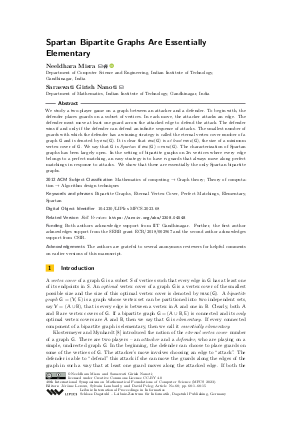Spartan Bipartite Graphs Are Essentially Elementary
Authors
Neeldhara Misra  ,
Saraswati Girish Nanoti
,
Saraswati Girish Nanoti
-
Part of:
Volume:
48th International Symposium on Mathematical Foundations of Computer Science (MFCS 2023)
Part of: Series: Leibniz International Proceedings in Informatics (LIPIcs)
Part of: Conference: Mathematical Foundations of Computer Science (MFCS) - License:
 Creative Commons Attribution 4.0 International license
Creative Commons Attribution 4.0 International license
- Publication Date: 2023-08-21
File

PDF
LIPIcs.MFCS.2023.68.pdf
- Filesize: 0.74 MB
- 15 pages
Document Identifiers
Related Versions
- Full Version https://arxiv.org/abs/2308.04548
Subject Classification
ACM Subject Classification
- Mathematics of computing → Graph theory
- Theory of computation → Algorithm design techniques
Keywords
- Bipartite Graphs
- Eternal Vertex Cover
- Perfect Matchings
- Elementary
- Spartan
Metrics
- Access Statistics
-
Total Accesses (updated on a weekly basis)
0Document
0Metadata
Abstract
We study a two-player game on a graph between an attacker and a defender. To begin with, the defender places guards on a subset of vertices. In each move, the attacker attacks an edge. The defender must move at least one guard across the attacked edge to defend the attack. The defender wins if and only if the defender can defend an infinite sequence of attacks. The smallest number of guards with which the defender has a winning strategy is called the eternal vertex cover number of a graph G and is denoted by evc(G). It is clear that evc(G) is at least mvc(G), the size of a minimum vertex cover of G. We say that G is Spartan if evc(G) = mvc(G). The characterization of Spartan graphs has been largely open. In the setting of bipartite graphs on 2n vertices where every edge belongs to a perfect matching, an easy strategy is to have n guards that always move along perfect matchings in response to attacks. We show that these are essentially the only Spartan bipartite graphs.
Cite As Get BibTex
Neeldhara Misra and Saraswati Girish Nanoti. Spartan Bipartite Graphs Are Essentially Elementary. In 48th International Symposium on Mathematical Foundations of Computer Science (MFCS 2023). Leibniz International Proceedings in Informatics (LIPIcs), Volume 272, pp. 68:1-68:15, Schloss Dagstuhl – Leibniz-Zentrum für Informatik (2023)
https://doi.org/10.4230/LIPIcs.MFCS.2023.68
BibTex
@InProceedings{misra_et_al:LIPIcs.MFCS.2023.68,
author = {Misra, Neeldhara and Nanoti, Saraswati Girish},
title = {{Spartan Bipartite Graphs Are Essentially Elementary}},
booktitle = {48th International Symposium on Mathematical Foundations of Computer Science (MFCS 2023)},
pages = {68:1--68:15},
series = {Leibniz International Proceedings in Informatics (LIPIcs)},
ISBN = {978-3-95977-292-1},
ISSN = {1868-8969},
year = {2023},
volume = {272},
editor = {Leroux, J\'{e}r\^{o}me and Lombardy, Sylvain and Peleg, David},
publisher = {Schloss Dagstuhl -- Leibniz-Zentrum f{\"u}r Informatik},
address = {Dagstuhl, Germany},
URL = {https://drops.dagstuhl.de/entities/document/10.4230/LIPIcs.MFCS.2023.68},
URN = {urn:nbn:de:0030-drops-186025},
doi = {10.4230/LIPIcs.MFCS.2023.68},
annote = {Keywords: Bipartite Graphs, Eternal Vertex Cover, Perfect Matchings, Elementary, Spartan}
}
Author Details
- Department of Computer Science and Engineering, Indian Institute of Technology, Gandhinagar, India
Funding
Both authors acknowledge support from IIT Gandhinagar. Further, the first author acknowledges support from the SERB grant ECR/2018/002967 and the second author acknowledges support from CSIR.
Acknowledgements
The authors are grateful to several anonymous reviewers for helpful comments on earlier versions of this manuscript.
References
-
Hisashi Araki, Toshihiro Fujito, and Shota Inoue. On the eternal vertex cover numbers of generalized trees. IEICE Trans. Fundam. Electron. Commun. Comput. Sci., 98-A(6):1153-1160, 2015.

-
Jasine Babu, L. Sunil Chandran, Mathew C. Francis, Veena Prabhakaran, Deepak Rajendraprasad, and J. Nandini Warrier. On graphs with minimal eternal vertex cover number. In Sudebkumar Prasant Pal and Ambat Vijayakumar, editors, Proceedings of the 5th International Conference on Algorithms and Discrete Applied Mathematics, CALDAM, volume 11394 of Lecture Notes in Computer Science, pages 263-273. Springer, 2019.

-
Jasine Babu, L. Sunil Chandran, Mathew C. Francis, Veena Prabhakaran, Deepak Rajendraprasad, and Nandini J Warrier. On graphs whose eternal vertex cover number and vertex cover number coincide. Discrete Applied Mathematics (in press), 2021.

-
Reinhard Diestel. Graph theory. Springer, 2017.

-
Fedor V. Fomin, Serge Gaspers, Petr A. Golovach, Dieter Kratsch, and Saket Saurabh. Parameterized algorithm for eternal vertex cover. Information Processing Letters, 110(16):702-706, 2010.

-
Gábor Hetyei. Rectangular configurations which can be covered by 2× 1 rectangles. Pécsi Tan. Foisk. Közl, 8:351-367, 1964.

-
William Klostermeyer and Christina M. Mynhardt. Graphs with equal eternal vertex cover and eternal domination numbers. Discrete Mathematics, 311(14):1371-1379, 2011.

-
William F. Klostermeyer and Christina M. Mynhardt. Edge protection in graphs. Australas. J Comb., 45:235-250, 2009.

-
László Lovász and Michael D Plummer. Matching theory, volume 367. American Mathematical Soc., 2009.

